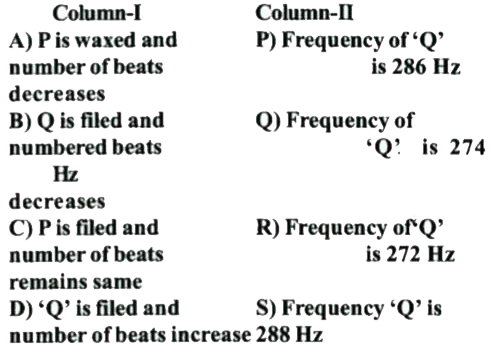A tuning fork having n = 300 Hz produces 5 beats/s with another tuning fork. If impurity (wax) is added on the arm of known tuning fork, the number of beats decreases then calculate the frequency of unknown tuning fork.
To solve the problem, we need to determine the frequency of the unknown tuning fork based on the information given about the beats produced when it is played with a known tuning fork of frequency 300 Hz.
1. Understanding Beats:
- The number of beats produced when two tuning forks are played together is equal to the absolute difference in their frequencies.
- If the known tuning fork has a frequency f1=300Hz and the unknown tuning fork has a frequency f2, then the number of beats per second is given by:
|f1−f2|=number of beats
2. Setting Up the Equation:
- We know from the problem that the number of beats produced is 5 beats per second. Therefore, we can write:
|300−f2|=5
3. Solving the Absolute Value Equation:
- The absolute value equation |300−f2|=5 can be split into two cases:
1. 300−f2=5
2. 300−f2=−5
- Solving the first case:
300−f2=5⟹f2=300−5=295Hz
- Solving the second case:
300−f2=−5⟹f2=300+5=305Hz
- Thus, the possible frequencies for the unknown tuning fork are f2=295Hz or f2=305Hz.
4. Considering the Effect of Impurity:
- When wax is added to the known tuning fork (300 Hz), its frequency decreases.
- If the frequency of the known tuning fork decreases, the number of beats produced must also decrease if the unknown tuning fork's frequency is higher than 300 Hz.
- Since the problem states that the number of beats decreases after adding wax, it implies that the unknown frequency must be less than 300 Hz.
5. Conclusion:
- Therefore, the only feasible frequency for the unknown tuning fork, given that the number of beats decreases, is:
f2=295Hz
Final Answer:
The frequency of the unknown tuning fork is 295Hz.
---
- The number of beats produced when two tuning forks are played together is equal to the absolute difference in their frequencies.
- If the known tuning fork has a frequency f1=300Hz and the unknown tuning fork has a frequency f2, then the number of beats per second is given by:
|f1−f2|=number of beats
- We know from the problem that the number of beats produced is 5 beats per second. Therefore, we can write:
|300−f2|=5
- The absolute value equation |300−f2|=5 can be split into two cases:
1. 300−f2=5
2. 300−f2=−5
300−f2=5⟹f2=300−5=295Hz
300−f2=−5⟹f2=300+5=305Hz
- When wax is added to the known tuning fork (300 Hz), its frequency decreases.
- If the frequency of the known tuning fork decreases, the number of beats produced must also decrease if the unknown tuning fork's frequency is higher than 300 Hz.
- Since the problem states that the number of beats decreases after adding wax, it implies that the unknown frequency must be less than 300 Hz.
- Therefore, the only feasible frequency for the unknown tuning fork, given that the number of beats decreases, is:
f2=295Hz
The frequency of the unknown tuning fork is 295Hz.
Topper's Solved these Questions
Similar Questions
A tuning fork having n = 158 Hz, produce 3 beats/s with another. As we file the arm of unknown, beats become 7 then calculate the frequency of unknown.
View SolutionA tuning fork A produces 5 beats/sec with another tuning fork B of frequency 256 Hz. If tuning fork A produces 1 beats/sec with some other tuning fork C of frequency 250 Hz, then calculate the frequency of fork A.
View Solution
Knowledge Check
A tuning fork 'P' of frequency 280Hz produces 6 beats/s with unknown tuning fork 'Q'
 AABCDQRSRBABCDQRQPCABCDP.QQ.RR.SPDABCDR.SQ.RSR
AABCDQRSRBABCDQRQPCABCDP.QQ.RR.SPDABCDR.SQ.RSRA tuning fork gives 5 beats with another tuning fork of frequency 100 Hz . When the first tuning fork is loaded with wax, then the number of beats remains unchanged, then what will be the frequency of the first tuning fork
A95 HzB100HzC105 HzD110 HzA tuning fork A produces 4 beats/second with another tuning fork of frequency 246 Hz. When the prongs of A are filed a little, the number of beats heard is 6 per second. What is the original frequency of the fork A?
A242 HzB240 HzC250 HzD252 Hz
A tuning fork A, marked 512 Hz, produces 5 beats per second, when sounded with another unmarked tuning fork B. If B is loaded with wax, the number of beats is again 5 per second. What is the frequency of tuning fork B when not loaded?
View SolutionThe frequency of tuning fork 'A' is 250Hz. It produces 6 beats/sec, when sounded together with another tunning fork B. If its arms are loaded with wax then it produces 4 beats/sec. Find the frequency of tuning fork B.
View SolutionA tuning fork arrangement (pair) produces 4beats/sec with one fork of frequency 288cps. A little wax is placed on the unknown fork and it then produces 2beats/sec. The frequency of the unknown fork is
View SolutionA tuning fork arrangement (pair) produces 4beats/sec with one fork of frequrncy 288cps. A little wax is placed on the unknown fork and it then produces 2beats/sec. The frequency of the unknown fork is
View SolutionTwo tuning forks having frequency 256 Hz (A) and 262 Hz (B) tuning fork. A produces some beats per second with unknown tuning fork, same unknown tuning fork produce double beats per second from B tuning fork then the frequency of unknown tuning fork is :-
View Solution
